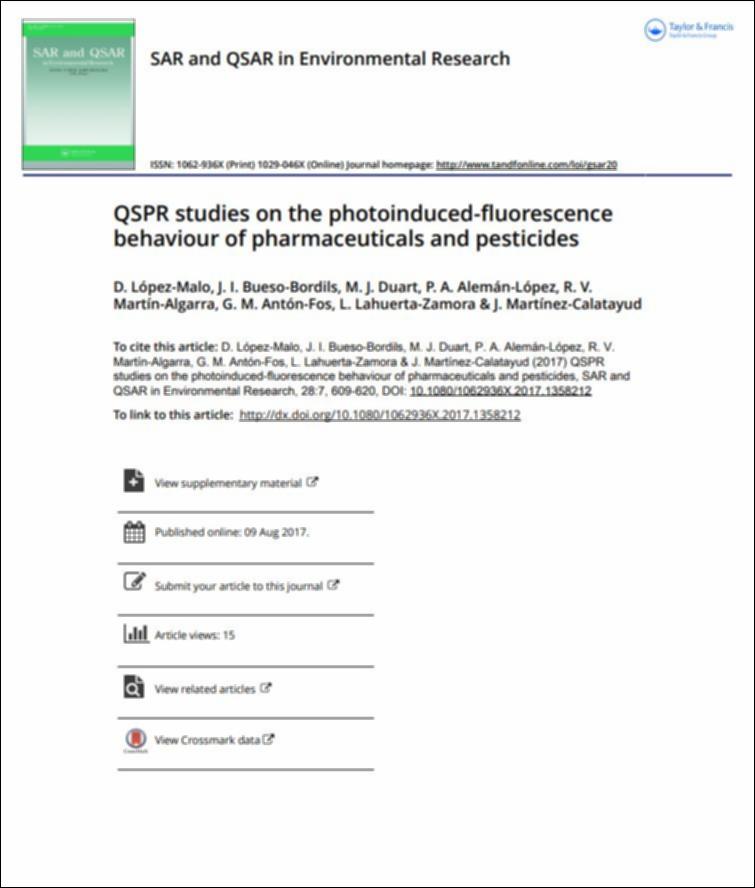Por favor, use este identificador para citar o enlazar este ítem:
http://hdl.handle.net/10637/15417QSPR studies on the photoinduced-fluorescence behaviour of pharmaceuticals and pesticides

Ver/Abrir:
QSPR_Lopez_SQER_2017.JPG
77,33 kB
JPEG
Ver/Abrir:
QSPR_Lopez_SQER_2017.pdf
Acceso restringido
1,45 MB
Adobe PDF
Request a copy
| Título : | QSPR studies on the photoinduced-fluorescence behaviour of pharmaceuticals and pesticides |
| Autor : | López Malo, Daniel Bueso Bordils, José Ignacio Duart Duart, María José Alemán López, Pedro Martín Algarra, Rafael Vicente Antón Fos, Gerardo Manuel Lahuerta Zamora, Luis Martínez Calatayud, José |
| Materias: | Pesticidas; Pesticides; Fluorescencia; Fluorescence; Microbiología farmacéutica; Pharmaceutical microbiology; Radiación ultravioleta; Ultraviolet radiation; Medicamentos; Drugs |
| Editorial : | Informa UK |
| Citación : | López-Malo, D., Bueso-Bordils, J.I., Duart, M.J., Alemán-López, P.A., Martín-Algarra, R.V., Antón-Fos, G.M., Lahuerta-Zamora, L. & Martínez-Calatayud, J. (2017). QSPR studies on the photoinduced-fluorescence behaviour of pharmaceuticals and pesticides. SAR and QSAR in Environmental Research, vol. 28, i. 7 (jul.), pp. 609–620. DOI: https://doi.org/10.1080/1062936X.2017.1358212 |
| Resumen : | Fluorimetric analysis is still a growing line of research in the determination of a wide range of organic compounds, including pharmaceuticals and pesticides, which makes necessary the development of new strategies aimed at improving the performance of fluorescence determinations as well as the sensitivity and, especially, the selectivity of the newly developed analytical methods. In this paper are presented applications of a useful and growing tool suitable for fostering and improving research in the analytical field. Experimental screening, molecular connectivity and discriminant analysis are applied to organic compounds to predict their fluorescent behaviour after their photodegradation by UV irradiation in a continuous flow manifold (multicommutation flow assembly). The screening was based on online fluorimetric measurement and comprised pre-selected compounds with different molecular structures (pharmaceuticals and some pesticides with known 'native' fluorescent behaviour) to study their changes in fluorescent behaviour after UV irradiation. Theoretical predictions agree with the results from the experimental screening and could be used to develop selective analytical methods, as well as helping to reduce the need for expensive, time-consuming and trial-and-error screening procedures. |
| Descripción : | Este recurso no está disponible en acceso abierto por política de la editorial. |
| URI : | http://hdl.handle.net/10637/15417 |
| Derechos: | http://creativecommons.org/licenses/by-nc-nd/4.0/deed.es |
| ISSN : | 1062-936X 1029-046X (Electrónico) |
| Fecha de publicación : | jul-2017 |
| Centro : | Universidad Cardenal Herrera-CEU |
| Aparece en las colecciones: | Dpto. Farmacia |
Los ítems de DSpace están protegidos por copyright, con todos los derechos reservados, a menos que se indique lo contrario.

